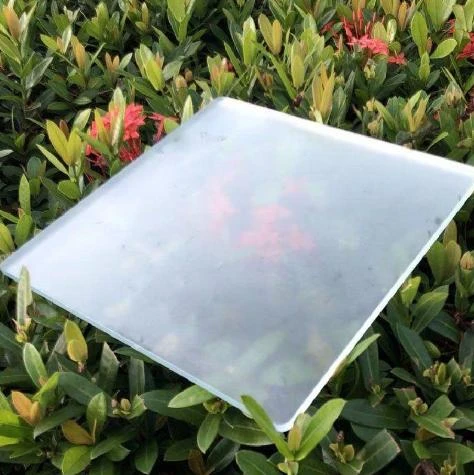The Float Glass Process An Overview
The float glass process is one of the most common methods for producing flat glass, used widely in various applications including windows, mirrors, and glass doors. This technique, which was developed in the mid-20th century, revolutionized the glass manufacturing industry with its efficiency and ability to produce high-quality glass sheets.
History and Development
The float glass process was invented by Sir Alistair Pilkington in the 1950s. Before this innovation, glass was often produced through methods that resulted in uneven thickness and surface imperfections. Pilkington's method involved floating molten glass on top of molten tin, which resulted in a smooth, flat surface. This breakthrough significantly improved the quality of glass, meeting the rising demand for flat glass in the construction and automotive industries.
Principle of the Float Glass Process
The fundamental principle of the float glass process involves the use of two layers of molten materials molten glass and molten tin. The process begins with the melting of raw materials such as silica sand, soda ash, and limestone in a furnace. The temperature in the furnace can reach up to 1600 degrees Celsius (approximately 2912 degrees Fahrenheit), allowing the raw materials to form a homogeneous molten glass.
Once the glass reaches a uniform consistency, it is carefully poured onto the surface of molten tin. Because glass is less dense than tin, it floats on top of the tin layer, which provides an incredibly flat surface and ensures that the glass maintains a consistent thickness. The glass sheet is then allowed to pass through a controlled cooling process known as annealing, where the glass is gradually cooled to relieve internal stresses and ensure stability.
Characteristics of Float Glass
Float glass produced through this process exhibits several notable characteristics. Firstly, the surface is extremely flat, which is essential for applications requiring optical clarity such as mirrors and high-quality windows. Additionally, the thickness of float glass can be easily controlled during production, allowing manufacturers to produce various thicknesses depending on the intended use.
the float glass process
Another key characteristic of float glass is its transparency, which is enhanced by the minimal surface distortion achieved through the floating process. The uniformity and clarity of float glass make it a preferred choice for architectural applications, where aesthetics and visibility are crucial.
Environmental Considerations
The float glass process is also notable for its relatively low environmental impact compared to other glass manufacturing methods. The use of molten tin not only aids in producing a high-quality product but also allows for the recycling of glass. The glass cullet can be added back into the process, which reduces the amount of raw material needed and minimizes energy consumption.
Furthermore, advancements in technology have led to the development of more energy-efficient furnaces and methods of heat recovery, contributing to lower carbon emissions and a reduced ecological footprint. Many float glass manufacturers are now focusing on sustainable practices, including the responsible sourcing of raw materials and the implementation of closed-loop systems.
Applications of Float Glass
The applications of float glass are vast and varied. It serves as a crucial component in the construction industry, where it is used for windows, facades, and skylights. Additionally, float glass is widely utilized in the automotive industry for windshields and side windows. Its clarity and strength make it an ideal choice for residential and commercial buildings alike.
In the realm of interior design, float glass is often employed in the manufacturing of mirrors and decorative glass elements, bringing both functionality and aesthetic appeal to spaces. Moreover, with advancements in technology, float glass can also be treated for specific functionalities, such as low-emissivity coatings that improve thermal insulation.
Conclusion
The float glass process has significantly transformed the glass manufacturing industry, providing a reliable method for producing high-quality flat glass that meets the demands of modern applications. As environmental considerations become increasingly important, the float glass process continues to evolve, adapting to the needs of a sustainable future while maintaining its pivotal role in various industries. The combination of efficiency, quality, and versatility ensures that float glass will remain a cornerstone of glass production for years to come.
 Afrikaans
Afrikaans  Albanian
Albanian  Amharic
Amharic  Arabic
Arabic  Armenian
Armenian  Azerbaijani
Azerbaijani  Basque
Basque  Belarusian
Belarusian  Bengali
Bengali  Bosnian
Bosnian  Bulgarian
Bulgarian  Catalan
Catalan  Cebuano
Cebuano  Corsican
Corsican  Croatian
Croatian  Czech
Czech  Danish
Danish  Dutch
Dutch  English
English  Esperanto
Esperanto  Estonian
Estonian  Finnish
Finnish  French
French  Frisian
Frisian  Galician
Galician  Georgian
Georgian  German
German  Greek
Greek  Gujarati
Gujarati  Haitian Creole
Haitian Creole  hausa
hausa  hawaiian
hawaiian  Hebrew
Hebrew  Hindi
Hindi  Miao
Miao  Hungarian
Hungarian  Icelandic
Icelandic  igbo
igbo  Indonesian
Indonesian  irish
irish  Italian
Italian  Japanese
Japanese  Javanese
Javanese  Kannada
Kannada  kazakh
kazakh  Khmer
Khmer  Rwandese
Rwandese  Korean
Korean  Kurdish
Kurdish  Kyrgyz
Kyrgyz  Lao
Lao  Latin
Latin  Latvian
Latvian  Lithuanian
Lithuanian  Luxembourgish
Luxembourgish  Macedonian
Macedonian  Malgashi
Malgashi  Malay
Malay  Malayalam
Malayalam  Maltese
Maltese  Maori
Maori  Marathi
Marathi  Mongolian
Mongolian  Myanmar
Myanmar  Nepali
Nepali  Norwegian
Norwegian  Norwegian
Norwegian  Occitan
Occitan  Pashto
Pashto  Persian
Persian  Polish
Polish  Portuguese
Portuguese  Punjabi
Punjabi  Romanian
Romanian  Russian
Russian  Samoan
Samoan  Scottish Gaelic
Scottish Gaelic  Serbian
Serbian  Sesotho
Sesotho  Shona
Shona  Sindhi
Sindhi  Sinhala
Sinhala  Slovak
Slovak  Slovenian
Slovenian  Somali
Somali  Spanish
Spanish  Sundanese
Sundanese  Swahili
Swahili  Swedish
Swedish  Tagalog
Tagalog  Tajik
Tajik  Tamil
Tamil  Tatar
Tatar  Telugu
Telugu  Thai
Thai  Turkish
Turkish  Turkmen
Turkmen  Ukrainian
Ukrainian  Urdu
Urdu  Uighur
Uighur  Uzbek
Uzbek  Vietnamese
Vietnamese  Welsh
Welsh  Bantu
Bantu  Yiddish
Yiddish  Yoruba
Yoruba  Zulu
Zulu 

